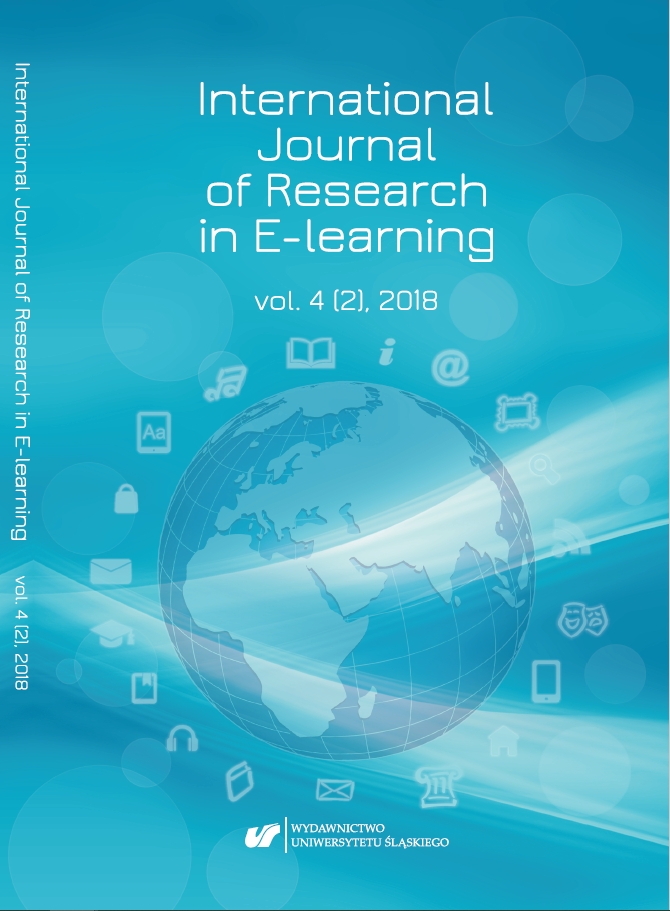Andrievska, V. & Olefirenko, N. (2010). Mulʹtimedìjnì tehnologìï u počatkovìj lancì osvìti /Multimedia technologies in the elementary level of education/ (in Ukrainian). Ìnformacìjnì tehnologìï ì zasobi navčannâ /Information Technologies and Teaching Aids/, 2, 6–12.
Erofeeva, N. (2012). Osnovy gendernoj pedagogiki /Fundamentals of gender pedagogy/ (in Russian). Textbook. Izhevsk: Udmurt University Publishing House.
Gerasimchuk, B. (2004). Rekomendacìï ŝodo stvorennâ ì provedennâ slajd-lekcìj /Recommendations for creating and conducting slide lectures/ (in Ukrainian). Lutsk: LSTU.
Haran, M. (2016). Perevìrka efektivnostì vikoristannâ mulʹtimedìjnogo metodičnogo kompleksu u procesì metodičnoï pìdgotovki majbutnìh učitelìv počatkovih klasìv do navčannâ matematiki /Checking the effectiveness of the use of multimedia methodical complex in the process of methodical preparation of future primary school teachers to mathematics training/ (in Ukrainian). In: Pedagogìka ta psihologìâ: sučasnij stan rozvitku naukovih doslìdžen’ ta perspektivi / Pedagogy and psychology: the current state of development of scientific research and prospects/ (pp. 43–47). Zaporizhzhia: КPU.
Khripkova, A., Antropova, M., & Farber, D. (1990). Vozrastnaâ fiziologiâ i škol’naâ gigiena /Age physiology and school hygiene/ (in Russian). Učeb. posobie [dlâ studentov ped. in-tov] / textbook, manual (for students ped. Inst.). Moskva: Enlightenment.
Kon, I. (2006). Meždisciplinarnye issledovaniâ. Sociologiâ. Psihologiâ. Seksologiâ. Antropologiâ /Interdisciplinary studies. Sociology. Psychology. Sexology. Anthropology/ (in Russian). Rostov- on-Don: Phoenix.
Lin, L., Leh, A., Kim, J. H. Y., & Baylen, D. M. Leveraging the design and development of multimedia presentations for learners. Accessed 5 February 2018. Retrieved from https://www.igi-global.com/chapter/leveraging-the-design-and-development... for-learners/189530?camid=4v1.
Luzghina, A. & Tokarieva, H. (2007). Struktura kontenta medialekcii /Content structure of media collection/ (in Russian). Accessed 5 February 2018. Retrieved from http://conf.evarussia.ru/eva2007/eng/reports/content_1092.html.
Meixner, B. (2017). Hypervideos and interactive multimedia presentations. Journal ACM Computing Surveys, 50(1), article no. 9.
Mokrohuz, O. (2012). Do pitannâ ergonomìčnostì mulʹtimedìjnoï prezentacìï âk faktoru ïï efektivnostì /The issue of ergonomics of a multimedia presentation as a factor in its effectiveness/ (in Ukrainian). Komp`ûter u školì ta sìm`ï /Computer at School and Family/, 3, 47–49.
Morse, N. (2012). Proektuvannâ, stvorennâ ta vikoristannâ navčalʹnih mulʹtimedìjnih prezentacìj âk rozvitku mislennâ učnìv /Designing, creating and using educational multimedia presentations as students' thinking development/ (in Ukrainian). Accessed 5 February 2018. Retrieved from http://www.nbuv.gov.ua/ejournals/ITZN/em2/content/07dnpsts.html.
Piaget, J. (2001). Teoriâ, èksperimenty, diskussiâ /Theory, experiments, discussion/ (in Russian). Moskva: Ed. Academics.
Ryzhenko, S. (2009). Pro dosvìd vikoristannâ mulʹtimedìjnih tehnologìj u navčalʹnomu procesì (u VNZ) /About the experience of using multimedia technologies in the educational process (in higher education institutions/ (in Ukrainian). Accessed 5 February 2018. Retrieved from http:// www.ime.edu-ua.net/em11/content/09rssseh.htm.
Ryzhov, V., Kornienko, A., & Demidovich, D. (2002). Kačestvo èkrannyh izobraženij v obučaûŝih programmah /The quality of screen images in training programs/ (in Russian). Pedagogičeskaâ ìnformatika /Pedagogical Informatics/, 1, 42–55.
Skafa, O. & Tutova, O. (2013). Evristične navčannâ matematiki: komp`ûterno-orìêntovanì uroki/Heuristic teaching of mathematics: computer-oriented lessons/ (in Ukrainian). Teaching manual:2nd edition. Donetsk: DonNU.
Skvortsova, S. & Haievets, Y. (2013). Pìdgotovka majbutnìh učitelìv počatkovih klasìv do navčannâ molodših školârìv rozv`âzuvati sûžetnì matematičnì zadačì /Future primary school teachers’ training for teaching primary school students to solve narrative mathematical problems/ (in Ukrainian). Monograph. Kharkiv: Ranok-NT.
Skvortsova, S. & Haran, M. (2016). Vrahuvannâ psiho-fìzìologìčnih osoblivostej studentìv âk vimogado podannâ navčalʹnoï ìnformacìï u prezentacìâh lekcìj /The consideration of psycho- physiological peculiarities of students as a requirement for presentation of educational information in presentations of lectures/ (in Ukrainian). In: Social and economic priorities in the context of sustainable development (pp. 371–377). Monograph. Opole: The Academy of Management and Administration in Opole.
Smyrnova-Trybulska, E., Ogrodzka-Mazur, E., Szafrańska-Gajdzica, A., Drlík, M., Cápay, M., Tomanová, J., Švec, P., Morze, N., Makhachashvili, R., Romanyukha, M., Nakazny, M., Sorokina, L., Issa, Tomayess, & Issa, Theodora. (2016). Recommended applications for making presentations and didactic videos. Some research results. In M. Turčáni, Z. Balogh, M. Munk, & L. Benko, Proceedings from DIVAI 2016 – The 11th International Scientific Conference on Distance Learning in Applied Informatics (pp. 235–246). Accessed 5 February 2018. Retrieved from http://elibrary.kubg.edu.ua/18713/1/R_ Makhachashvili_Mkonf_05_2016_GI.pdf.
Smyrnova-Trybulska, E., Ogrodzka-Mazur, E., Szafrańska-Gajdzica, A., Morze, N., Makhachashvili, R., Drlík, M., Cápay, M., Tomanová, J., Švec, P., Issa, Tomayess, Issa, Theodora, Romanyukha, M., Nakazny, M., & Sorokina, L. (2015). Discussion paper on more adequate and effective IT tools. Some previous results concerning more adequate and effective IT tools in the category: tools for making presentations. International Journal of Research in E-learning, 1(1), 77–96.
Tkach, Yu. (2011). Okremì osoblivostì stvorennâ mulʹtimedìjnih prezentacìj /Some features of creating multimedia presentations/. Accessed 5 February 2018. Retrieved from http://ir.stu.cn.ua/bitstream/handle/123456789/5929/Article_Multimedia.p....
Viun, V., Huz, I., Shyshlakov, M., & Demydenko, A. (2012) Mulʹtimedìa tehnologìï v pìslâdiplomnìj osvìtì /Multimedia technologies in postgraduate education/ (in Ukrainian). In: Materìali XXXIX navčalʹno-metodičnoï konferencìï «Cučasnij stan ta perspektivi pìdgotovki lìkarìv- ìnternìv u harkìvsʹkomu nacìonalʹnomu medičnomu unìversitetì», 11 kvìtnâ 2012 r. /Modern condition and prospects of training intern doctors in Kharkiv National Medical University/ (pp. 21–24). Kharkiv: Kharkiv National Medical University.
Google Scholar


